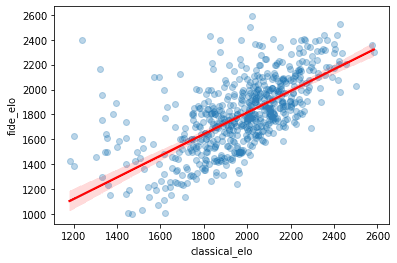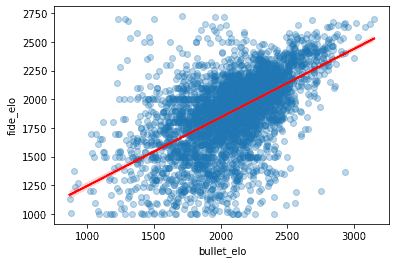Introduction
Probably you started playing chess on lichess and wondered how your lichess rating compares to an actual FIDE Elo rating. On lichess.org, you usually start with a rating of 1500. This leads to the ratings being normally distributed around this value which we can see here. However, even if you play regularly, you may find that the lichess rating seems a little high compared to other chess websites such as chess.com. So could you possibly really keep up with certain tournament chess players if you have a lichess rating over 1200, or is there a catch when it comes to lichess ratings? This is the question I set out to answer in this post.
The analysis
For the analysis, I downloaded the dataset of all lichess games played in December 2021, which you can obtain here. I then extracted a list of the most frequent players from a larger subset of the data. To obtain the lichess ratings and the FIDE rating of a player, I scraped thousands of profiles of the previously extracted frequent players. You can easily do this using the lichess API. The profiles contain ratings in different disciplines on lichess.org and an optional self-supplied FIDE rating. After some minor data cleaning, such as removing implausible FIDE ratings, I have around 3800 player profiles with self-stated FIDE ratings.
Fitting a simple regression model and plotting the results leaves us with the following graphics.




Generally speaking, you can see from the plots that there definitely is a correlation between lichess ratings and FIDE Elos. However, you can also see that your lichess ratings might be a little high. Concretely, to get a value that represents your possible FIDE rating more closely, you should subtract around 200-300 points from your respective lichess rating. However, this doesn’t always hold true, as there is a significant variance in FIDE Elo between players with a seemingly equal lichess rating and vice versa. When looking at players with higher ratings, this variance decreases, and the lichess ratings seem to be more meaningful. I hope you enjoyed this little glimpse on online chess ratings and hope to be doing some more detailed analysis soon!
Conclusion
The comparison of ratings of different chess platforms or chess platforms and actual FIDE Elo scores is only possible to a limited extent. Looking at the data however can give as some intuition on how the ratings might correspond to each other. In this case, looking at simple correlation plots provides us with a way to come up with a simple transformation formula. Note that while we compared the ratings of a specific platform with self-supplied FIDE ratings of thousands of players there are also websites such as chessratingcomparison.com that use self-submitted data of chess players to offer comparisons between different platforms such as chess.com and lichess.org